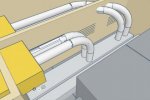JuliaTruchsess
Member
- Location
- Newtown, CT, USA
- Occupation
- Engineer
376.2 defines metal wireways as "sheet metal troughs with hinged or removable covers". I have a wireway going across the tops of a few equipment cabinets to house wires going between the cabinets. During installation, I can certainly have the top cover be removable in order to "lay my conductors in place", but ultimately there is some conduit going into the top cover, and once this is installed with its conductors inside, the cover is not going to be very easily "removable", for inspection or any other reason. Is this a problem?
I could conceivably make a side removable or hinged, but that will be quite difficult to get to as well, due to a nearby partition that will go up after the equipment is installed.
I could conceivably make a side removable or hinged, but that will be quite difficult to get to as well, due to a nearby partition that will go up after the equipment is installed.

